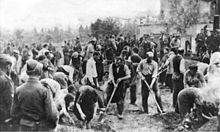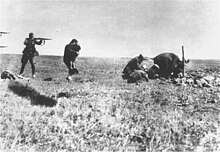The Holocaust in Ukraine
The Holocaust in Ukraine took place during the Occupation of Ukraine by Nazi Germany.[1] Between 1941 and 1945, approximately 3,000,000 Ukrainian and other non-Jewish victims were killed as part of Nazi extermination policies, along with between 850,000 - 900,000 Jews who lived in the territory of modern Ukraine.[2][3]
Generalplan Ost


One of Hitler's ambitions at the start of the war was to exterminate, expel, or enslave most or all Slavs from their native lands so as to make living space for German settlers. This plan of genocide[4] was to be carried into effect gradually over a period of 25–30 years.[5]
Death squads (1941–1943)
Total civilian losses during the war and German occupation in Ukraine are estimated at four million, including up to a million Jews who were murdered by the Einsatzgruppen and local Nazi collaborators. Einsatzgruppe C (SS-Gruppenführer Dr. Otto Rasch) was assigned to north and central Ukraine, and Einsatzgruppe D (SS-Gruppenführer Dr. Otto Ohlendorf) to Moldavia, south Ukraine, the Crimea, and, during 1942, the north Caucasus. According to Ohlendorf at his trial, "the Einsatzgruppen had the mission to protect the rear of the troops by killing the Jews, Romani, Communist functionaries, active Communists, uncooperative slavs, and all persons who would endanger the security." In practice, their victims were nearly all Jewish civilians (not a single Einsatzgruppe member was killed in action during these operations[citation needed]). The United States Holocaust Memorial Museum tells the story of one survivor of the Einsatzgruppen in Piryatin, Ukraine, when they killed 1,600 Jews on April 6, 1942, the second day of Passover:
I saw them do the killing. At 5:00 p.m. they gave the command, "Fill in the pits." Screams and groans were coming from the pits. Suddenly I saw my neighbor Ruderman rise from under the soil … His eyes were bloody and he was screaming: "Finish me off!" … A murdered woman lay at my feet. A boy of five years crawled out from under her body and began to scream desperately. "Mommy!" That was all I saw, since I fell unconscious.[6]
The most notorious massacre of Jews in Ukraine was at the Babi Yar ravine outside Kiev, where 33,771 Jews were killed in a single operation on September 29–30, 1941. (An amalgamation of 100,000 to 150,000 Ukrainian and other Soviet citizens were also killed in the following weeks). The mass killing of Jews in Kiev was decided on by the military governor Major-General Friedrich Eberhardt, the Police Commander for Army Group South (SS-Obergruppenführer Friedrich Jeckeln) and the Einsatzgruppe C Commander Otto Rasch. It was carried out by a mixture of SS, SD and Security Police, assisted by the Ukrainian Auxiliary Police. On the Monday, the Jews of Kiev gathered by the cemetery, expecting to be loaded onto trains. The crowd was large enough that most of the men, women, and children could not have known what was happening until it was too late: by the time they heard the machine-gun fire, there was no chance to escape. All were driven down a corridor of soldiers, in groups of ten, and then shot. A truck driver described the scene:
Jews of the city of Kiev and vicinity! On Monday, September 29, you are to appear by 08:00 a.m. with your possessions, money, documents, valuables, and warm clothing at Dorogozhitskaya Street, next to the Jewish cemetery. Failure to appear is punishable by death.
— Order posted in Kiev in Russian and Ukrainian, on or around September 26, 1941.[7]
[O]ne after the other, they had to remove their luggage, then their coats, shoes, and overgarments and also underwear … Once undressed, they were led into the ravine which was about 150 meters long and 30 meters wide and a good 15 meters deep … When they reached the bottom of the ravine they were seized by members of the Schutzmannschaft and made to lie down on top of Jews who had already been shot … The corpses were literally in layers. A police marksman came along and shot each Jew in the neck with a submachine gun … I saw these marksmen stand on layers of corpses and shoot one after the other … The marksman would walk across the bodies of the executed Jews to the next Jew, who had meanwhile lain down, and shoot him.[7]

Massacres
Executor units
- Einsatzgruppen C & D (Einsatzkommando)
- Abwehr/Brandemburg special saboteur unit Nachtigall Battalion
- Freiwilligen-Stamm-Regiment 3 & 4 (Russians & Ukrainians)
- Ukrainische Hilfspolizei
Survivors
- Mina Rosner
- Stefan Petelycky - see "Into Auschwitz, for Ukraine" (Kashtan Press, 2008), available at www.uccla.ca
Righteous among the Nations
Ukraine rates the 4th in the number of people recognized as "Righteous among the Nations" for saving Jews during the Holocaust, with the total of 2272 individuals recognized to date.[8]
The religious Christian sect, the Shtundists, helped hide Jews in Ukraine during the Holocaust.[citation needed]
See also
- History of the Jews in Ukraine
- Hegewald (colony)
- No Place on Earth, a 2012 documentary film on a group of Ukrainian Jews who survived the height of The Holocaust in the Verteba and Priest's Grotto caves
References
- ^ Andrew Gregorovich, World War II in Ukraine: Jewish Holocaust in Ukraine
- ^ Magocsi, Paul Robert (1996). A History of Ukraine. University of Toronto Press. p. 633.
- ^ Dawidowicz, Lucy S. (1986). The war against the Jews, 1933–1945. New York: Bantam Books. ISBN 0-553-34302-5.p. 403
- ^ DIETRICH EICHHOLTZ "»Generalplan Ost« zur Versklavung osteuropäischer Völker"[1]
- ^ Madajczyk, Czesław. "Die Besatzungssysteme der Achsenmächte. Versuch einer komparatistischen Analyse." Studia Historiae Oeconomicae vol. 14 (1980): pp. 105-122 [2] in Hitler's War in the East, 1941-1945: A Critical Assessment by Gerd R. Uebersch̀ear and Rolf-Dieter Müller [3]
- ^ a b Berenbaum, Michael. The World Must Know. United States Holocaust Memorial Museum, Johns Hopkins University Press, 2nd edition, 2006, p. 93.
- ^ a b Berenbaum, Michael. The World Must Know, United States Holocaust Memorial Museum, this edition 2006, pp. 97–98.
- ^ http://www1.yadvashem.org/yv/en/righteous/statistics.asp
